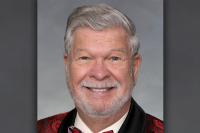Most Bryson City business owners OK with county financing train improvements
 Most Everett Street business owners support Swain County’s pending investment in the privately owned Great Smoky Mountain Railroad, but some have questions about the mechanics of exactly how the deal will work.
Most Everett Street business owners support Swain County’s pending investment in the privately owned Great Smoky Mountain Railroad, but some have questions about the mechanics of exactly how the deal will work.
Committee wants to start fundraising for Swain library
Bryson City town leaders have given a verbal OK to the idea of building a new library — but the when, where and how are all still unknown.
“The library is an essential service for the community,” said Chester Bartlett, chairman of Marianna Black Library’s Board of Trustees and leader of a committee charged with taking the lead on the new library. “We feel there is a huge need for this.”
Spicing up Southern Appalachia
 Though the weather is getting colder and winter is emerging on the horizon, Doug Weaver is all smiles.
Though the weather is getting colder and winter is emerging on the horizon, Doug Weaver is all smiles.
It’s open season for chili.
“Chili itself is not just a dish, it’s a state of mind,” he said. “There’s no better spicy food than chili. It’s an institution.”
Swain seals deal to bring steam engine to Great Smoky Mountain Railroad lines
 Swain County leaders have pledged $700,000 to help the Great Smoky Mountain Railroad expand its already bustling operations in Bryson City.
Swain County leaders have pledged $700,000 to help the Great Smoky Mountain Railroad expand its already bustling operations in Bryson City.
No shortage of critics as Kephart play comes home
 For a man who has just won the North Carolina Literature Award, writer Gary Carden is quite somber.
For a man who has just won the North Carolina Literature Award, writer Gary Carden is quite somber.
At his home in Sylva last week, he rocked in a chair on the front porch, his trusty dog Jack lying nearby. He was recently informed of the award, but it seems bittersweet. His latest creation — and a catalyst for the achievement — is the play “Outlander,” a historical drama about famed writer Horace Kephart who chronicled the lives of hardscrabble Appalachian settlers in the early 1900s.
Setting the stage: Wave plus water equals ideal freestyle paddling venue
 The steep-walled gorge of Nantahala River may be one of the best spots to host a world class, extreme kayak competition — at least that’s what the organizers of the upcoming 2012 International Canoe Federation Freestyle World Cup final are hoping.
The steep-walled gorge of Nantahala River may be one of the best spots to host a world class, extreme kayak competition — at least that’s what the organizers of the upcoming 2012 International Canoe Federation Freestyle World Cup final are hoping.
The competition, slated for Sep. 7-9 in front of the Nantahala Outdoor Center, will feature over more than freestyle kayaking, squirt-boating and canoeing athletes from more than a dozen countries, including Australia, Costa Rica, Slovakia, Japan and Russia. But the secret to making the river a churning pool of boat acrobatics and assorted water moves is hidden beneath the surface.
Business boost from paddling World Cup hasn’t materialized yet
Economic development and tourism leaders in Swain County are treating the Freestyle Kayaking World Cup two weeks away as a dry run for the far more highly anticipated World Freestyle Kayaking Championship coming in 2013.
“This will start the ball rolling with the exposure,” said Ken Mills, the economic development director for Swain County. “For us, this is kind of a dress rehearsal.”
Former Bryson Fire Chief and wife charged with embezzlement
Former Bryson City Fire Chief Joey Hughes and his wife, Cylena, were arrested and indicted on embezzlement, fraud, and other charges last week for allegedly purloining money from the volunteer fire department’s fundraising arm.
More than $200,000 was taken over several years, according to the charges brought by the State Bureau of Investigation. The Hughes were indicted by a grand jury last week on 48 counts.
Former Bryson fire chief charged in connection with fire department funds
The former Bryson City fire chief Joey Hughes is facing criminal charges following a months-long investigation by the State Bureau of Investigation into missing funds from fire department coffers.
His wife, Cylena Hughes, has also been charged in connection with missing funds from the fire department. She was a signatory of two fund-raising arms of the fire department — the Friends of the Firemen and the Ladies’ Auxiliary. Donations from the community to the fire department were funneled through these accounts, which were solely controlled by the Hughes.
Mothers unite to pray for schools
By Peggy Manning • Correspondent
Every Friday morning, a small group of mothers meet in Bryson City to pray for students, teachers and school administrators. Called Moms in Prayer, the sessions last about an hour and focus on issues participants are concerned about in the school system, said organizer Brona Winchester.









